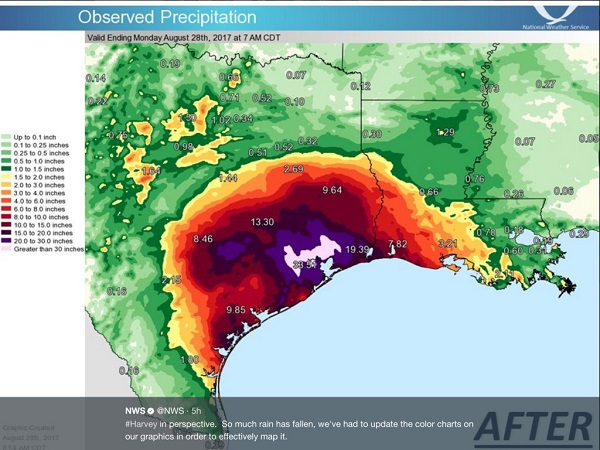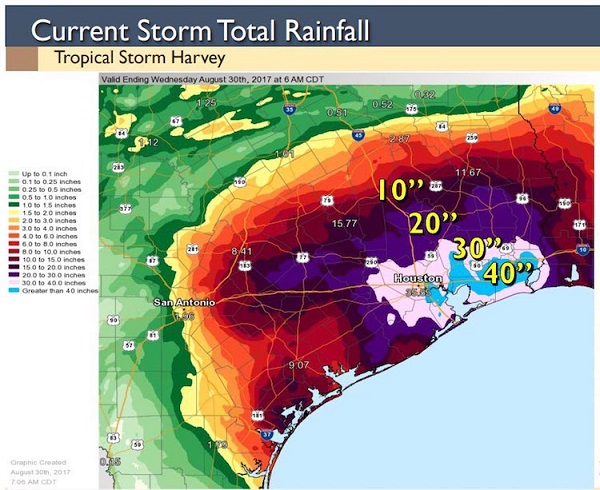Well, not everywhere, it’s dry here this winter, but definitely in Texas, and in India, Nepal, Bangladesh and now Pakistan. In fact, in the Indian subcontinent more than 1,400 people are dead since the recent rains started, and more than 45 million are directly affected, many having had their livelihoods destroyed. Mumbai, a city of some 20 million people, had a month’s rain in a single day. Two-thirds of Bangladesh was said to be under water. Here’s an early map from August 29:

I think it got a lot worse after that. The New Daily has described the South Asia floods as the world’s forgotten ‘catastrophe’.
The commentary seems to indicate that the deluge was the worst in about 30 years, although some say the worst anyone knows about. No doubt climate change made matters worse.
The Texas event was termed a one in 1000 year event. Michael Mann was early to finger climate change. No-one is saying that climate change caused Harvey, but as Joe Romm says Climate change made every stage of Hurricane Harvey more horrific. The latest I’ve heard is a death toll of over 50 and rising, plus more than 1 million people displaced.
For perspective, Texas is 696,241 square kilometres as against New South Wales with 800,642. It’s population is 27,862,000, more than Australia’s. Here is an image of the rain from August 28:

A feature is the way the system sat in one place for days on end after landfall, then moved to the east, bringing heavy rain to Louisiana. A significant number of Katrina refugees relocated to Houston and now have been hit a second time. Last year August Baton Rouge suffered a storm that killed 13 people. I’ve heard one estimate that it will take 10 years for Texas to recover. For some it will be never.
Ilan Kelman, researcher on risk and disaster reduction, says, don’t blame Hurricane Harvey, blame society. Essentially, in his view, humans are to blame for putting themselves in harm’s way. Not sure where he thinks the safe spots are on the globe, and what the planet’s true carrying capacity is.
Eventually climate attribution scientists will come up with a study, as they did, for example, on Europe’s June heat (about 3 degrees Celsius above the 1981-2010 average). The team found that such temperatures are no longer rare, but occur roughly every 10 to 30 years. And:
- The team found that climate change made the intensity and frequency of such extreme heat at least twice as likely in Belgium, at least four times as likely in France, Switzerland, the Netherlands, and central England and at least 10 times as likely in Portugal and Spain.
Carbon Brief has a post Attributing extreme weather to climate change in real-time as to how it’s done, and Mapped: How climate change affects extreme weather around the world. The looked at 140 studies:
- Carbon Brief’s analysis suggests 63% of all extreme weather events studied to date were made more likely or more severe by human-caused climate change. Heatwaves account for nearly half of such events (46%), droughts make up 21% and heavy rainfall or floods account for 14%.
See also What made the rain in Hurricane Harvey so extreme?
There is an overall impression that in the US public authorities were much better prepared this time than they were for Katrina. However, public perception of risk was low, which will now change.
Other features of the floods include a fifth of US oil refinery capacity shutting down, there were twin explosions from chemical plants, and five toxic Superfund sites flooded:
- “If floodwaters have spread the chemicals in the waste pits, then dangerous chemicals like dioxin could be spread around the wider Houston area,” TexPIRG researcher Kara Cook-Schultz told the AP. “Superfund sites are known to be the most dangerous places in the country, and they should have been properly protected against flooding.”
Numerous other industrial sites were damaged. Fire ants cling together in a bunch and float. Here’s neat image from ZME Science:

NPR was giving out information about what to do – basically, get out of the way:
- “…people shouldn’t try to poke the raft or try to drown them by pushing it underwater. It will backfire, he says: “If anybody comes in contact with that, hits it, well then, the ants immediately will stream onto that person just like they would onto a log or onto a bank because they’re looking for high ground.”
If you think that is trivial or irrelevant, take a look at this:

There’s more at Weather Underground including this map of rainfall to August 30:

At that time Cedar Bayou had received 51.88” of rain – that’s over 1.3 metres – a new all-time record for any tropical cyclone in the continental US.
There’s a comprehensive entry at Wikipedia, and before and after photos at Quartz.
I won’t spend a lot of time on Trump. He’s probably lucky that he hadn’t gotten around to vandalising this area of public infrastructure yet except rolling back flood standards last month and now perhaps having second thoughts.
He started OK by flying to Texas but deciding to stay out of the way. Then he messed up by tweeting that he’s witnessed the devastation first hand, which was a lie. This was as close as he got:

Then there was something about Melania’s shoes.
- The Environmental Protection Agency on Tuesday rejected climate scientists’ efforts to explain that global warming worsened Harvey’s impacts, calling the explanations “attempts to politicize” the historic flooding in Texas.
The EPA’s cynical statement is not only wrong, it indicates that the Trump administration will fail a critical test for this natural disaster — figuring out how to prevent future such catastrophes.
While California is burning, with all-time record heat.


Texas Republicans Helped Chemical Plant That Exploded Lobby Against Safety Rules:
Russ Schumacher, Associate Professor of Atmospheric Science, Colorado State University, at The Conversation:
What made the rain in Hurricane Harvey so extreme?
What Hurricane Harvey says about risk, climate and resilience.
And:
12 Years After Katrina, Hurricane Harvey Pummels Gulf Coast and Its Climate Science-Denying Politicians.